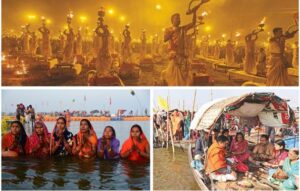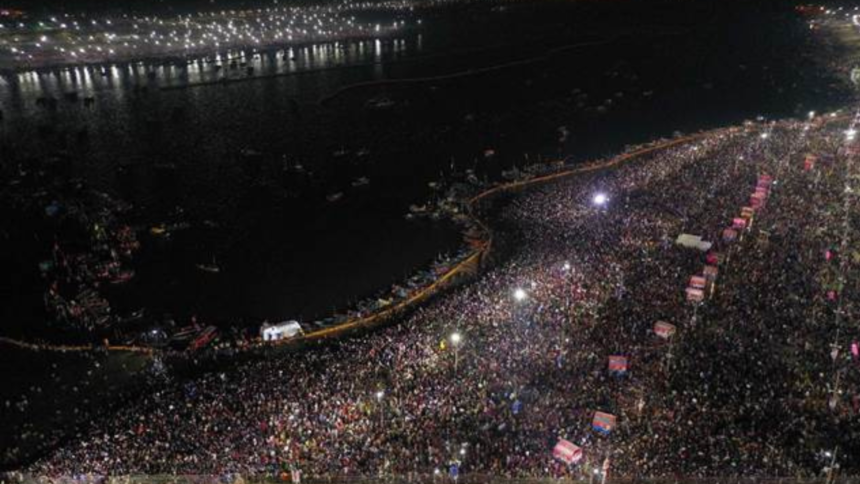NewzVille Desk
World’s largest spiritual gathering ‘The Maha Kumbh Mela’ is a breathtaking convergence of faith, culture, and ancient tradition. Rooted in Hindu mythology, this sacred festival unfolds four times over a course of twelve years, rotating between four revered cities in India: Haridwar, Ujjain, Nashik, and Prayagraj, each situated along the banks of the holiest rivers—the Ganges, Shipra, Godavari, and the sangam of the Ganges, Yamuna, and Saraswati.
Next year in 2025, from 13 January to 26 February, Prayagraj will once again become the heart of this magnificent celebration, drawing millions of pilgrims and visitors to witness a great display of devotion, unity, and the vibrant expression of India’s spiritual heritage.

Shahi Snan
The Maha Kumbh Mela is a grand assembly of rituals, with the bathing ceremony standing as the most significant of them all. Held at the Triveni Sangam, millions of pilgrims gather to take part in this sacred practice, which is deeply rooted in the belief that immersing oneself in the holy waters can cleanse an individual of all sins. This act of purification is believed to liberate both the individual and their ancestors from the cycle of rebirth, ultimately leading to Moksha, or spiritual liberation.
Pilgrims also engage in worship along the banks of the sacred river and participate in enlightening discourses led by sadhus and saints, adding a layer of spiritual depth to the experience. While taking a dip in the holy waters is considered sacred throughout the entire Prayagraj Maha Kumbh, certain dates hold special significance like Paush Purnima (January 13), Makar Sankranti (January 14) etc. These dates see magnificent processions featuring saints, their disciples, and members of various Akharas (religious orders), all partaking in the grand ritual known as Shahi Snan, or ‘Rajyogi Snan.’ This marks the official commencement of the Maha Kumbh Mela and is the central highlight of the event.
Aarti
The mesmerizing Ganga Aarti ceremony on the riverbanks is an unforgettable sight for the participants. During this sacred ritual, priests perform intricate ceremonies while holding glowing lamps, offering a visual spectacle. The Ganga Aarti attracts thousands of devotees, evoking profound devotion and reverence for the sacred river.
Kalpavas
Kalpavas offers seekers a sacred retreat dedicated to spiritual discipline, austerity, and higher consciousness. Derived from Sanskrit, “Kalpa” means cosmic aeon, and “Vas” refers to dwelling, symbolizing a period of intense spiritual practice. Pilgrims participating in Kalpavas embrace a life of simplicity, renouncing worldly comforts and engaging in daily rituals like meditation, prayers, and scripture study. The practice also includes Vedic Yajnas and Homas, sacred fire rituals that invoke divine blessings, and Satsangs, spiritual discourses for intellectual and devotional growth. This immersive experience fosters deepened devotion and spiritual transformation within the larger pilgrimage.
Prayers and Offerings
Devotees perform Dev Pujan to honor deities believed to visit the Sangam during the Kumbh. Rituals such as Shraadh (offering food and prayers to ancestors) and Veeni Daan (offering hair to the Ganges) are integral to the festival, symbolizing surrender and purification. Satsang, or associating with truth, is another core practice where devotees listen to discourses by saints and scholars. This exchange of wisdom fosters a deeper understanding of spirituality, inspiring attendees to pursue higher self-realization. Philanthropy holds immense significance during Kumbh. Acts of giving, such as Gau Daan (donation of cows), Vastra Daan (donation of clothes), Dravya Daan (donating of money) and Swarn Daan (gold), are considered meritorious.
Deep Daan
During the Kumbh Mela in Prayagraj, the ritual of Deep Daan transforms the sacred rivers into a mesmerizing spectacle. Devotees float thousands of lighted earthen lamps (Diyas) on the flowing waters of the Triveni Sangam as an offering of gratitude. These lamps, often crafted from wheat flour and filled with oil, create a celestial glow that reflects divine brilliance, symbolizing spirituality and devotion. The sight of twinkling Diyas on the river, set against the backdrop of the Mela, fills the atmosphere with a profound sense of religious fervor and unity, leaving an indelible impression on pilgrims.
Prayagraj Panchkoshi Parikrama
The historical ritual of rounding Prayagraj has been revived to reconnect pilgrims with ancient practices. This journey encompasses sacred landmarks like the Dwadash Madhav and other significant temples, offering spiritual fulfilment while preserving cultural heritage. The aim is to revive a historic ritual while offering the younger generation an opportunity to connect with and appreciate the rich cultural, religious, and spiritual heritage of this significant event.
Other Attractions of Maha Kumbh Mela
In addition to the rituals and practices of the Maha Kumbh Mela, there are several other captivating attractions that make the event in 2025 even more remarkable. Prayagraj, known for its sacred significance as the confluence of the Ganga, Yamuna, and Saraswati rivers, is a key destination for pilgrims. The revered Triveni Sangam, where the three rivers meet, is a must-visit for anyone attending the Mela. This sacred spot offers a deeply spiritual experience, drawing millions of devotees and travellers from across the globe.
To have a unique and unforgettable experience there are some amazing places to explore and distinctive culture to adhere.
Temples
Beyond the religious rituals, Prayagraj offers a rich array of cultural, historical, and architectural gems. The city is home to a number of ancient temples, such as the Hanuman Mandir, Alopi Devi Mandir, and Mankameshwar Temple, each of which holds great religious significance and offers a glimpse into the city’s deep spiritual heritage. These temples, with their intricate designs and age-old legends, are a testament to the city’s longstanding connection to Hindu traditions.
City Architecture
For history enthusiasts, Prayagraj also boasts significant historical landmarks, such as the Ashoka Pillar. This ancient edifice stands as a reminder of India’s rich historical past, with inscriptions that reflect the country’s ancient civilization. The city’s colonial-era architecture, including structures like the University of Allahabad Building and Swaraj Bhawan, further adds to the allure of the region. These buildings provide a fascinating glimpse into the architectural grandeur of the British colonial period.
Local Markets
Prayagraj’s vibrant cultural heritage is another highlight for visitors. The pilgrims can also explore the bustling streets and markets, and experience the local culture, art, and cuisine, all of which offer a unique window into the life of the city. In addition to these historical and cultural treasures, Prayagraj is also home to esteemed educational institutions like Allahabad University, often referred to as the “Oxford of the East.” This prestigious university has played a significant role in shaping India’s intellectual landscape over the years.
Akhara camps
The Akhara camps at the Kumbh Mela provide a unique opportunity for spiritual seekers, sadhus, and ascetics to gather, discuss philosophy, meditate, and share their wisdom. These camps are not just places of worship but spaces where deeper spiritual exchanges occur, offering a truly enriching experience for anyone attending the Maha Kumbh Mela.
Together, these attractions make the Maha Kumbh Mela a celebration of faith, culture, and history, providing once in a life time, unforgettable divine journey for all who participate.





